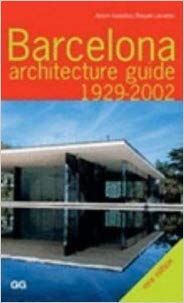 1929 and 1992 are two highly significant moments in the urban evolution of Barcelona. The first, marked by the great International Exhibition, saw the development of Montjuïc and completion of the avenues and promenades envisaged in the 1859 Cerdà Plan. In 1992, with the Summer Olympic Games, the city concluded a new and far more ambitious series of urban reforms, in which new architecture played a major part. This book has been structured in three parts: 1929-1950, the years dominated by the Noucentista architecture; 1951-1977, with a more diverse architecture -Group R, the Barcelona School- and an evident desire to open up to the outside world, and a third period, 1978-2002, in which political situation favoured major growth in public architecture. With a total of 162 entries, each comprising an explanatory text, one or two photographs and, in many cases, a plan, this guide offers a complete introduction to the best architecture constructed in Barcelona during the period 1929-2002.
1929 and 1992 are two highly significant moments in the urban evolution of Barcelona. The first, marked by the great International Exhibition, saw the development of Montjuïc and completion of the avenues and promenades envisaged in the 1859 Cerdà Plan. In 1992, with the Summer Olympic Games, the city concluded a new and far more ambitious series of urban reforms, in which new architecture played a major part. This book has been structured in three parts: 1929-1950, the years dominated by the Noucentista architecture; 1951-1977, with a more diverse architecture -Group R, the Barcelona School- and an evident desire to open up to the outside world, and a third period, 1978-2002, in which political situation favoured major growth in public architecture. With a total of 162 entries, each comprising an explanatory text, one or two photographs and, in many cases, a plan, this guide offers a complete introduction to the best architecture constructed in Barcelona during the period 1929-2002.
 1929 and 1992 are two highly significant moments in the urban evolution of Barcelona. The first, marked by the great International Exhibition, saw the development of Montjuïc and completion of the avenues and promenades envisaged in the 1859 Cerdà Plan. In 1992, with the Summer Olympic Games, the city concluded a new and far more ambitious series of urban reforms, in which new architecture played a major part. This book has been structured in three parts: 1929-1950, the years dominated by the Noucentista architecture; 1951-1977, with a more diverse architecture -Group R, the Barcelona School- and an evident desire to open up to the outside world, and a third period, 1978-2002, in which political situation favoured major growth in public architecture. With a total of 162 entries, each comprising an explanatory text, one or two photographs and, in many cases, a plan, this guide offers a complete introduction to the best architecture constructed in Barcelona during the period 1929-2002.
1929 and 1992 are two highly significant moments in the urban evolution of Barcelona. The first, marked by the great International Exhibition, saw the development of Montjuïc and completion of the avenues and promenades envisaged in the 1859 Cerdà Plan. In 1992, with the Summer Olympic Games, the city concluded a new and far more ambitious series of urban reforms, in which new architecture played a major part. This book has been structured in three parts: 1929-1950, the years dominated by the Noucentista architecture; 1951-1977, with a more diverse architecture -Group R, the Barcelona School- and an evident desire to open up to the outside world, and a third period, 1978-2002, in which political situation favoured major growth in public architecture. With a total of 162 entries, each comprising an explanatory text, one or two photographs and, in many cases, a plan, this guide offers a complete introduction to the best architecture constructed in Barcelona during the period 1929-2002.